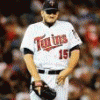-
Posts
68 -
Joined
-
Last visited
Profile Information
-
Location:
Washington, DC
Contact Methods
-
Website URL
https://twitter.com/glp_vt
-
Personal Blog Name
Bloop Singles
- Personal Blog URL
Social
-
Twitter
glp_vt
Greg Logan's Achievements
-
 Dman reacted to a post in a topic:
Ranking the Twins Top-5 Hit Tool Prospects
Dman reacted to a post in a topic:
Ranking the Twins Top-5 Hit Tool Prospects
-

Ranking the Twins Top-5 Hit Tool Prospects
Greg Logan replied to Cody Christie's topic in Twins Minor League Talk
Great read. Sabato's really intriguing too. Longenhagen has him at 55 FV for both hit and game power, and his defensive limitations are the main thing holding back his prospect stock. From a purely hitting standpoint I'm looking forward to what we see in full-season ball. -
 nclahammer reacted to a blog entry:
BaseballTradeValues.com is your new favorite website
nclahammer reacted to a blog entry:
BaseballTradeValues.com is your new favorite website
-

BaseballTradeValues.com is your new favorite website
Greg Logan commented on Greg Logan's blog entry in Bloop Singles
They consider him to have some value, but I think the challenge with Sano would be finding a team that's currently selling but still needs a 3B/1B for 2020 and 2021. That seems like a tight needle to thread. -
 dbminn reacted to a comment on a blog entry:
BaseballTradeValues.com is your new favorite website
dbminn reacted to a comment on a blog entry:
BaseballTradeValues.com is your new favorite website
-

BaseballTradeValues.com is your new favorite website
Greg Logan commented on Greg Logan's blog entry in Bloop Singles
This is fair, but I think in that case we need to be realistic about the caliber of starter we'd receive in a trade. Guys like deGrom and Syndergaard aren't going to change hands without a potentially franchise-changing prospect attached. I also think this is a reason we're hearing chatter about the Padres and Syndergaard. They just have such a deep top of the farm to work from for that kind of deal. -

BaseballTradeValues.com is your new favorite website
Greg Logan commented on Greg Logan's blog entry in Bloop Singles
I like Rooker a lot too but he’s nearly MLB-ready and the Twins are deep at both OF and 1B. Rosario, Buxton, Kepler and Cron will all be back, and Sano will need to shift to 1B eventually. You never know with anyone, but Rooker feels as dispensable as anyone in the system. -

BaseballTradeValues.com is your new favorite website
Greg Logan posted a blog entry in Bloop Singles
The other day I was listening to one of my go-to baseball podcasts, Effectively Wild. The hosts interviewed John Bitzer, creator of BaseballTradeValues.com. BTV is designed to simulate trades scenarios and estimate relative value of the players included, and the model incorporates variables like projected performance, prospect rankings, committed salary, inflation, years of control, aging curve, and roster flexibility. The timing couldn't be better with the trade deadline fast approaching. I spent literal hours on BTV today and came up with some interesting scenarios. The site is quick to note that they won't be 100% accurate and don't factor in things like a specific club's propensity to spend or its roster needs, but even so, it's a great way to double-check your own assumptions about what a player on the Twins or a potential trade partner is worth relative to other trade chips. You could make a case that Royce Lewis should be a bit lower given his early season struggles or Jordan Balazovic should be significantly higher after a strong start, but most of the Twins values feel pretty close. Below are a few examples of trades BTV gave a thumbs up to as fair for both sides: Diamondbacks: Robbie Ray Twins: Brent Rooker, Nick Gordon, Fernando Romero Blue Jays: Marcus Stroman, Ken Giles Twins: Brusdar Graterol, Nick Gordon, LaMonte Wade Jr. Mets: Noah Syndergaard Twins: Royce Lewis, Lewis Thorpe Mets: Jacob deGrom Twins: Alex Kirilloff, Nick Gordon Giants: Madison Bumgarner, Will Smith Twins: Wander Javier, Lewis Thorpe Comment with some trades you work out on BTV! -
 3balls2strikes reacted to a blog entry:
By the Numbers: The Twins’ Biggest Missed Opportunity
3balls2strikes reacted to a blog entry:
By the Numbers: The Twins’ Biggest Missed Opportunity
-
 BK432 reacted to a blog entry:
By the Numbers: The Twins’ Biggest Missed Opportunity
BK432 reacted to a blog entry:
By the Numbers: The Twins’ Biggest Missed Opportunity
-
 Richie the Rally Goat reacted to a post in a topic:
Article: By the Numbers: The Twins’ Biggest Missed Opportunity
Richie the Rally Goat reacted to a post in a topic:
Article: By the Numbers: The Twins’ Biggest Missed Opportunity
-
Every artist gets asked the question ‘Where do you get your ideas?’ The honest artist answers ‘I steal them.’ - Austin Kleon As Twins fans, we tend to look at roster moves through Twins-colored glasses. We know there are approaches to roster construction and talent acquisition outside of the Falvey/Levine mold and we try our best to keep track of them, but it’s difficult and time consuming to monitor 29 other rosters for ideas the Twins could adopt. Unfortunately opposing players don’t have 'amateur free agent' or 'trade acquisition' on their jerseys along with their name and number.The good news, friends, is that your humble author has done the hard work for you. Over the past few weeks I’ve studied the teams that made the 2018 postseason in an effort to better understand to what degree they relied on homegrown talent (i.e. drafted and signed internationally) and external talent (i.e. free agents and trade acquisitions) to reach the postseason. I looked at every player that suited up for these clubs and tracked how they were acquired and how they performed. The results were surprising and fascinating, showing one key area where the Twins have fallen behind - an opportunity they can’t afford to continue to miss if they want to return to the postseason. Before we dive in, a few notes on methodology: All WAR figures are based on FanGraphs’ WAR formula. If you aren’t a fan of WAR, you may want to turn back now, but you’re reading a baseball site on Super Bowl Sunday so my guess is we’re safe.The 2019 Twins projections below are FanGraphs’ Depth Chart projections, which are a blend of Steamer’s projection system and playing time estimates by FanGraphs’ staff.Several types of averages below help summarize the postseason field as a whole, including median, unweighted average (mean) and weighted average. The weighted average favor the clubs that advanced further into the postseason (crediting 19 games for advancing to the World Series, 12 games for advancing to the league championship series, and so forth). So the Red Sox are weighted more heavily in that average than the A’s, for example.The “Small Market Average” is an average of Cleveland, Oakland, Milwaukee and Colorado, meant to represent the postseason clubs more closely aligned with the Twins’ revenues and spending capabilities.Okay, let’s get started. Homegrown Talent Any conversation around Minnesota’s underwhelming 2018 starts with the struggles of Byron Buxton and Miguel Sano, but readers may be surprised by how competitive the Twins’ homegrown core was relative to those of the postseason clubs, even factoring in Buxton's and Sano’s struggles. Let’s take a closer look at the numbers: Download attachment: HomegrownChart.png In fact, players the Twins drafted or signed as amateur international free agents contributed 19.6 wins to the 2018 club, roughly even with the average playoff team. Among the contending clubs, the Red Sox and Rockies led the way with 23.7 and 23.5 wins respectively from their homegrown talent, while the Brewers managed to lead the National League in wins despite only 3.6 wins’ worth of production from players they’d drafted or signed internationally. Fangraphs projects the Twins’ drafted and international signings to continue to produce at or above the level of a postseason team in 2019, but 2018 showed us that this won’t be enough to take the club to October. So if the Twins maintained pace with baseball’s best in homegrown production and still fell short, where did the eventual postseason clubs pull away? Free Agency The state of free agency has been a hot topic this offseason, and it’s no secret to Twins fans that the free agent market wasn’t kind to their club in 2018. Logan Morrison, Lance Lynn and Addison Reed fell flat, and key free agent investments from previous offseasons Ervin Santana and Jason Castro were non-factors. Let’s take a look at free agent production as compared to the 2018 playoff teams: Download attachment: FAWAR1.png Download attachment: FAWAR2.png While the Twins got a mere 1.3 wins from players acquired via free agency, playoff teams enjoyed an average of nearly 8 wins apiece. There were outliers even within one division, with the Dodgers needing nearly 14 wins from former free agents to squeak into the postseason while the Rockies needed less than 2 free agent wins to do the same. The NL West race also demonstrates a split in strategy between larger- and smaller-market teams, with the smaller predictably relying less on free agents than their larger-market counterparts. If Twins fans are looking for some good news, it’s unlikely their luck will be nearly as poor in 2019. FanGraphs has rosy projections for former free agents Nelson Cruz, Michael Pineda and Jonathan Schoop, but a return to the postseason will likely hinge on every ounce of the 13.5 wins FanGraphs projects the Twins getting from players acquired in free agency. But here’s where things get interesting, because if the homegrown core still looks promising and the free agent acquisitions appear poised for fairly strong production, there’s only one player acquisition strategy left that jumps off the page as a missed opportunity for the Twins, and if you took a close look at the charts above you may be way ahead of me. The Trade Market While last year’s playoff teams may have had a step up on the Twins in free agency, they absolutely torched the Twins when it came to finding surplus value in the trade market. Let’s take another look at the breakdown of external production: Download attachment: TradeWAR1.png Download attachment: TradeWAR2.png Outside of the trade for Jake Odorizzi, the Twins have been largely absent from the trade market, and it shows when you compare them to the best teams in baseball. Excluding midseason trades, which we’ll omit due to the Twins having very different goals in those trades than the other teams on this list, trade acquisitions contributed only 6.1 wins to the Twins in 2018, and those were largely concentrated between Odorizzi and erstwhile fan favorite Eduardo Escobar. By comparison, 2018’s postseason teams averaged a whopping 17.9 wins from players acquired via trade, again excluding midseason trades. That’s nearly 40% of their production coming from such trades, and the number balloons to nearly 50% when you look at just the smaller market clubs. The A’s and the Indians have written the book on building a small market contender by acing the trade market, with the A’s acquiring over half their 2018 production and the Indians acquiring four of five pieces of a dynamic rotation (all of whom were worth 4 or more WAR) via trade. If there’s one lesson to take from this review of the 2018 postseason field, it’s that effectively leveraging the trade market is critical to building a postseason contender, and the Twins have not kept pace with their competition. Twins fans have seen what can happen when trades go wrong, but we also saw in 2018 the effect that conservative trade activity can have on a club that has eyes on the postseason. Is it time to get out there and make some aggressive moves? Click here to view the article
-
The good news, friends, is that your humble author has done the hard work for you. Over the past few weeks I’ve studied the teams that made the 2018 postseason in an effort to better understand to what degree they relied on homegrown talent (i.e. drafted and signed internationally) and external talent (i.e. free agents and trade acquisitions) to reach the postseason. I looked at every player that suited up for these clubs and tracked how they were acquired and how they performed. The results were surprising and fascinating, showing one key area where the Twins have fallen behind - an opportunity they can’t afford to continue to miss if they want to return to the postseason. Before we dive in, a few notes on methodology: All WAR figures are based on FanGraphs’ WAR formula. If you aren’t a fan of WAR, you may want to turn back now, but you’re reading a baseball site on Super Bowl Sunday so my guess is we’re safe. The 2019 Twins projections below are FanGraphs’ Depth Chart projections, which are a blend of Steamer’s projection system and playing time estimates by FanGraphs’ staff. Several types of averages below help summarize the postseason field as a whole, including median, unweighted average (mean) and weighted average. The weighted average favor the clubs that advanced further into the postseason (crediting 19 games for advancing to the World Series, 12 games for advancing to the league championship series, and so forth). So the Red Sox are weighted more heavily in that average than the A’s, for example. The “Small Market Average” is an average of Cleveland, Oakland, Milwaukee and Colorado, meant to represent the postseason clubs more closely aligned with the Twins’ revenues and spending capabilities. Okay, let’s get started. Homegrown Talent Any conversation around Minnesota’s underwhelming 2018 starts with the struggles of Byron Buxton and Miguel Sano, but readers may be surprised by how competitive the Twins’ homegrown core was relative to those of the postseason clubs, even factoring in Buxton's and Sano’s struggles. Let’s take a closer look at the numbers: In fact, players the Twins drafted or signed as amateur international free agents contributed 19.6 wins to the 2018 club, roughly even with the average playoff team. Among the contending clubs, the Red Sox and Rockies led the way with 23.7 and 23.5 wins respectively from their homegrown talent, while the Brewers managed to lead the National League in wins despite only 3.6 wins’ worth of production from players they’d drafted or signed internationally. Fangraphs projects the Twins’ drafted and international signings to continue to produce at or above the level of a postseason team in 2019, but 2018 showed us that this won’t be enough to take the club to October. So if the Twins maintained pace with baseball’s best in homegrown production and still fell short, where did the eventual postseason clubs pull away? Free Agency The state of free agency has been a hot topic this offseason, and it’s no secret to Twins fans that the free agent market wasn’t kind to their club in 2018. Logan Morrison, Lance Lynn and Addison Reed fell flat, and key free agent investments from previous offseasons Ervin Santana and Jason Castro were non-factors. Let’s take a look at free agent production as compared to the 2018 playoff teams: While the Twins got a mere 1.3 wins from players acquired via free agency, playoff teams enjoyed an average of nearly 8 wins apiece. There were outliers even within one division, with the Dodgers needing nearly 14 wins from former free agents to squeak into the postseason while the Rockies needed less than 2 free agent wins to do the same. The NL West race also demonstrates a split in strategy between larger- and smaller-market teams, with the smaller predictably relying less on free agents than their larger-market counterparts. If Twins fans are looking for some good news, it’s unlikely their luck will be nearly as poor in 2019. FanGraphs has rosy projections for former free agents Nelson Cruz, Michael Pineda and Jonathan Schoop, but a return to the postseason will likely hinge on every ounce of the 13.5 wins FanGraphs projects the Twins getting from players acquired in free agency. But here’s where things get interesting, because if the homegrown core still looks promising and the free agent acquisitions appear poised for fairly strong production, there’s only one player acquisition strategy left that jumps off the page as a missed opportunity for the Twins, and if you took a close look at the charts above you may be way ahead of me. The Trade Market While last year’s playoff teams may have had a step up on the Twins in free agency, they absolutely torched the Twins when it came to finding surplus value in the trade market. Let’s take another look at the breakdown of external production: Outside of the trade for Jake Odorizzi, the Twins have been largely absent from the trade market, and it shows when you compare them to the best teams in baseball. Excluding midseason trades, which we’ll omit due to the Twins having very different goals in those trades than the other teams on this list, trade acquisitions contributed only 6.1 wins to the Twins in 2018, and those were largely concentrated between Odorizzi and erstwhile fan favorite Eduardo Escobar. By comparison, 2018’s postseason teams averaged a whopping 17.9 wins from players acquired via trade, again excluding midseason trades. That’s nearly 40% of their production coming from such trades, and the number balloons to nearly 50% when you look at just the smaller market clubs. The A’s and the Indians have written the book on building a small market contender by acing the trade market, with the A’s acquiring over half their 2018 production and the Indians acquiring four of five pieces of a dynamic rotation (all of whom were worth 4 or more WAR) via trade. If there’s one lesson to take from this review of the 2018 postseason field, it’s that effectively leveraging the trade market is critical to building a postseason contender, and the Twins have not kept pace with their competition. Twins fans have seen what can happen when trades go wrong, but we also saw in 2018 the effect that conservative trade activity can have on a club that has eyes on the postseason. Is it time to get out there and make some aggressive moves?
-
 nclahammer reacted to a blog entry:
By the Numbers: The Twins’ Biggest Missed Opportunity
nclahammer reacted to a blog entry:
By the Numbers: The Twins’ Biggest Missed Opportunity
-
 Thegrin reacted to a blog entry:
By the Numbers: The Twins’ Biggest Missed Opportunity
Thegrin reacted to a blog entry:
By the Numbers: The Twins’ Biggest Missed Opportunity
-
 ToddlerHarmon reacted to a blog entry:
By the Numbers: The Twins’ Biggest Missed Opportunity
ToddlerHarmon reacted to a blog entry:
By the Numbers: The Twins’ Biggest Missed Opportunity
-

By the Numbers: The Twins’ Biggest Missed Opportunity
Greg Logan posted a blog entry in Bloop Singles
“Every artist gets asked the question ‘Where do you get your ideas?’ The honest artist answers ‘I steal them.’” - Austin Kleon As Twins fans, we tend to look at roster moves through Twins-colored glasses. We know there are approaches to roster construction and talent acquisition outside of the Falvey/Levine mold and we try our best to keep track of them, but it’s difficult and time-consuming to monitor 29 other rosters for ideas the Twins could adopt. Unfortunately opposing players don’t have “amateur free agent” or “trade acquisition” on their jerseys along with their name and number. The good news, friends, is that your humble author has done the hard work for you. Over the past few weeks I’ve studied the teams that made the 2018 postseason in an effort to better understand to what degree they relied on homegrown talent (i.e. drafted and signed internationally) and external talent (i.e. free agents and trade acquisitions) to reach the postseason. I looked at every player that suited up for these clubs and tracked how they were acquired and how they performed. The results were surprising and fascinating, showing one key area where the Twins have fallen behind - an opportunity they can’t afford to continue to miss if they want to return to the postseason. Before we dive in, a few notes on methodology: All WAR figures are based on FanGraphs’ WAR formula. If you aren’t a fan of WAR, you may want to turn back now, but you’re reading a baseball site on Super Bowl Sunday so my guess is we’re safe. The 2019 Twins projections below are FanGraphs’ Depth Chart projections, which are a blend of Steamer’s projection system and playing time estimates by FanGraphs’ staff. Several types of averages below help summarize the postseason field as a whole, including median, unweighted average (mean) and weighted average. The weighted average favor the clubs that advanced further into the postseason (crediting 19 games for advancing to the World Series, 12 games for advancing to the league championship series, and so forth). So the Red Sox are weighted more heavily in that average than the A’s, for example. The “Small Market Average” is an average of Cleveland, Oakland, Milwaukee and Colorado, meant to represent the postseason clubs more closely aligned with the Twins’ revenues and spending capabilities. Okay, let’s get started. Homegrown Talent Any conversation around Minnesota’s underwhelming 2018 starts with the struggles of Byron Buxton and Miguel Sano, but readers may be surprised by how competitive the Twins’ homegrown core was relative to those of the postseason clubs, even factoring in Buxton and Sano’s struggles. Let’s take a closer look at the numbers: In fact, players the Twins drafted or signed as amateur international free agents contributed 19.6 wins to the 2018 club, roughly even with the average playoff team. Among the contending clubs, the Red Sox and Rockies led the way with 23.7 and 23.5 wins respectively from their homegrown talent, while the Brewers managed to lead the National League in wins despite only 3.6 wins’ worth of production from players they’d drafted or signed internationally. Fangraphs projects the Twins’ drafted and international signings to continue to produce at or above the level of a postseason team in 2019, but 2018 showed us that this won’t be enough to take the club to October. So if the Twins maintained pace with baseball’s best in homegrown production and still fell short, where did the eventual postseason clubs pull away? Free Agency The state of free agency has been a hot topic this offseason, and it’s no secret to Twins fans that the free agent market wasn’t kind to their club in 2018. Logan Morrison, Lance Lynn and Addison Reed fall flat, and key free agent investments from previous offseasons Ervin Santana and Jason Castro were non-factors. Let’s take a look at free agent production as compared to the 2018 playoff teams: While the Twins got a mere 1.3 wins from players acquired via free agency, playoff teams enjoyed an average of nearly 8 wins apiece. There were outliers even within one division, with the Dodgers needing nearly 14 wins from former free agents to squeak into the postseason while the Rockies needed less than 2 free agent wins to do the same. The NL West race also demonstrates a split in strategy between larger- and smaller-market teams, with the smaller predictably relying less on free agents than their larger-market counterparts. If Twins fans are looking for some good news, it’s unlikely their luck will be nearly as poor in 2019. FanGraphs has rosy projections for former free agents Nelson Cruz, Michael Pineda and Jonathan Schoop, but a return to the postseason will likely hinge on every ounce of the 13.5 wins FanGraphs projects the Twins getting from players acquired in free agency. But here’s where things get interesting, because if the homegrown core still looks promising and the free agent acquisitions appear poised for fairly strong production, there’s only one player acquisition strategy left that jumps off the page as a missed opportunity for the Twins, and if you took a close look at the charts above you may be way ahead of me. The Trade Market While last year’s playoff teams may have had a step up on the Twins in free agency, they absolutely torched the Twins when it came to finding surplus value in the trade market. Let’s take another look at the breakdown of external production: Outside of the trade for Jake Odorizzi, the Twins have been largely absent from the trade market, and it shows when you compare them to the best teams in baseball. Excluding midseason trades, which we’ll omit due to the Twins having very different goals in those trades than the other teams on this list, trade acquisitions contributed only 6.1 wins to the Twins in 2018, and those were largely concentrated between Odorizzi and erstwhile fan favorite Eduardo Escobar. By comparison, 2018’s postseason teams averaged a whopping 17.9 wins from players acquired via trade, again excluding midseason trades. That’s nearly 40% of their production coming from such trades, and the number balloons to nearly 50% when you look at just the smaller market clubs. The A’s and the Indians have written the book on building a small market contender by acing the trade market, with the A’s acquiring over half their 2018 production and the Indians acquiring four of five pieces of a dynamic rotation (all of whom were worth 4 or more WAR) via trade. If there’s one lesson to take from this review of the 2018 postseason field, it’s that effectively leveraging the trade market is critical to building a postseason contender, and the Twins have not kept pace with their competition. Twins fans have seen what can happen when trades go wrong, but we also saw in 2018 the effect that conservative trade activity can have on a club that has eyes on the postseason. Is it time to get out there and make some aggressive moves? -
It would be nice to find another left handed to complement Garver but pickins will be slim. Yasmani Grandal was rumored to be trade bait this offseason after Barnes got so much postseason playing time, but he’s been behind the plate more often than Barnes so far. Tucker Barnhart might be available?
- 75 replies
-
- jason castro
- mitch garver
-
(and 1 more)
Tagged with:
-
 jorgenswest reacted to a comment on a blog entry:
Robbie Grossman and the Twins’ lefty problem
jorgenswest reacted to a comment on a blog entry:
Robbie Grossman and the Twins’ lefty problem
-

Robbie Grossman and the Twins’ lefty problem
Greg Logan commented on Greg Logan's blog entry in Bloop Singles
I'm not ready to make that jump. With so many left-handers in this lineup you have to have someone who can hit LHP even at a league-average clip, and until we have more than a year's worth of PA's suggesting Grossman can't, you have to trust his track record. -
The Twins offense has been right around average so far in 2018, ranking 7th in the AL in runs scored per game and 9th in wRC+. It’s early, but if we assume that Logan Morrison, Robbie Grossman and Byron Buxton (once healthy) improve as the season progresses, and even if Max Kepler can’t maintain a 1.000 OPS and Ryan LaMarre isn’t the greatest hitter of our (or any) generation, the Twins offense should eventually settle closer to the top-5 offense they displayed in 2017. But in order to do so, they’ll need to address one potential weakness. Let’s consider the Opening Day lineup, the Twins' most frequently used to date, and their career OPS against left-handed pitching: Dozier - .889 Mauer - .742 Sano - .898 Rosario - .697 Morrison - .694 Escobar - .736 Kepler - .542 Buxton - .697 Castro - .564 Dozier and Sano both crush left-handed pitching, but among Twins Opening Day starters they represent the only two career marks above .745 (last year’s MLB average against LHP). It begs the question: are the Twins vulnerable to left-handed pitching? It’s a question Paul Molitor luckily hasn’t had to address with much frequency to start the season. Fewer than 17% of the Twins’ plate appearances have been against left-handed pitching so far, the second lowest rate in baseball. But the southpaws won’t be held at bay for long, and if Saturday’s lineup is any indication, Molitor is already exploring ways to mitigate the issue. With Rays left-hander Blake Snell on the mound, Molitor opted to bat Robbie Grossman fourth despite a horrendous .077/.143/.115 start to the season. It was a bold move to be sure, and Molitor deserves credit for looking past early-season struggles and even medium-term platoon splits to acknowledge Grossman’s longer-term track record of hitting left-handers. Across his career, Grossman owns a .750 OPS vs. LHP across 500 plate appearances. That OPS number places him behind only Dozier and Sano among Twins hitters, even after it declined a bit in 2017 with Grossman actually hitting better against right-handers. A single year’s sample of platoon splits is rarely as reliable as multiple years, and it’s encouraging to see Molitor making decisions based on the larger sample. It’s anyone’s guess how long it might take for Grossman to return to his usual production, but multiple seasons' worth of above-average hitting against left-handed pitching can’t be ignored, and we shouldn't be surprised if we continue to see Robbie Grossman's name penciled into the middle of the order against opposing left-handers.
-
I hadn't really thought about Lackey but he projects reasonably well if you're just trying to fill a 5th starter slot with something above replacement level. 2017 WAR: 0.5 (Fangraphs), 1.2 (BR), 0.7 (BP) 2018 proj fWAR : 1.4 (Steamer), 1.6 (ZiPS) Not bad if you're out on the "Big Four" and just trying to upgrade on Hughes/Slegers on a one-year deal. Certainly better than Tillman.
- 26 replies
-
- jaime garcia
- alex cobb
-
(and 3 more)
Tagged with:
-
Sort of. Santana, Berrios and Gibson are in the rotation regardless, so I think you have to look at it more as replacing Hughes/Slegers's replacement-level projection than replacing Gibson's 2-win projection. Teams value an incremental win at around $8M, which would mean Darvish should command a little over $32M for his 2018 projection. The question is how close will this market get him to that and how many years of it will the winner of his services have to agree to.
- 26 replies
-
- jaime garcia
- alex cobb
-
(and 3 more)
Tagged with:
-

Article: Adalberto Mejia: High Floor or More?
Greg Logan replied to Jamie Cameron's topic in Twins Daily Front Page News
This is great. I'm glad you used Berrios as a point of comparison because I see some similarities in their first-year control issues. Berrios in 2016 and Mejia in 2017 both had trouble finding the strike zone consistently with their fastball, and I think that allowed hitters to spit on their breaking pitches and wait for a fastball in the zone. Berrios went from a 6.9% BB rate in the minors to a 12.5% BB rate in his first year in the majors, but then he was able to drop it back down to 7.8% in 2017. Mejia's control issues weren't quite as extreme (5.3 in the minors to 9.9 in the majors), but if he can iron out the fastball control (and especially command since his breaking stuff isn't as electric as Berrios's), it could make a huge difference.











